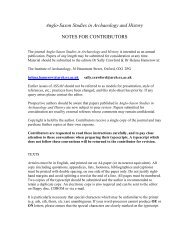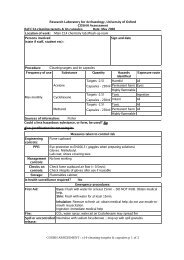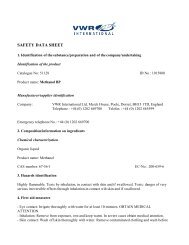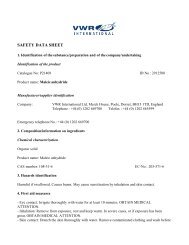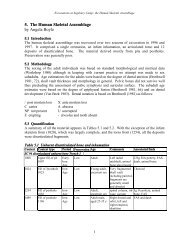Excavations and Survey at Androna, Syria: The ... - Dumbarton Oaks
Excavations and Survey at Androna, Syria: The ... - Dumbarton Oaks
Excavations and Survey at Androna, Syria: The ... - Dumbarton Oaks
- No tags were found...
You also want an ePaper? Increase the reach of your titles
YUMPU automatically turns print PDFs into web optimized ePapers that Google loves.
<strong>Excav<strong>at</strong>ions</strong> <strong>and</strong> <strong>Survey</strong> <strong>at</strong> <strong>Androna</strong>, <strong>Syria</strong>:<strong>The</strong> Oxford Team 2000MARLIA MUNDELL MANGO<strong>The</strong> third season of excav<strong>at</strong>ion <strong>at</strong> <strong>Androna</strong>(modern Andarin) took place in autumn2000. <strong>The</strong> work of the Oxford team in 1998 <strong>and</strong>1999 has been reported elsewhere. 1 <strong>The</strong> n<strong>at</strong>ureof the site, once a large <strong>and</strong> flourishing kome situ<strong>at</strong>edin the so-called basalt massif of northcentral <strong>Syria</strong>, <strong>and</strong> the current intern<strong>at</strong>ional archaeologicalproject (<strong>Syria</strong>n-British-German)are described in the report on the 1999 seasonpublished in DOP 56 (2002). <strong>The</strong> main aims ofthis project are to elucid<strong>at</strong>e the diachronic development(from Roman to Islamic) of <strong>Androna</strong>’sresources, defense, size, <strong>and</strong> sp<strong>at</strong>ial organiz<strong>at</strong>ionby means of survey <strong>and</strong> excav<strong>at</strong>ion.<strong>The</strong> Oxford team is concentr<strong>at</strong>ing on questionsrel<strong>at</strong>ing to the sources <strong>and</strong> use of w<strong>at</strong>er <strong>at</strong> thisdesert site. We have accordingly been excav<strong>at</strong>inga mid-sixth-century public b<strong>at</strong>h <strong>at</strong> the centerof the site, studying the extramural reservoirs,2 <strong>and</strong> investig<strong>at</strong>ing all evidence rel<strong>at</strong>ing toagriculture. Our work continued in 2000 withthe excav<strong>at</strong>ion of the b<strong>at</strong>h, where our principalobjectives were to complete excav<strong>at</strong>ion of themain rooms <strong>and</strong> to investig<strong>at</strong>e its he<strong>at</strong> <strong>and</strong> w<strong>at</strong>ersupply. 31For 1998 see M. Mundell Mango, “Oxford <strong>Excav<strong>at</strong>ions</strong><strong>at</strong> Andarin (<strong>Androna</strong>): September 1998,” with contributionsby M. Decker, C. Mango, N. Pollard, C. Salter, <strong>and</strong>A. Wilson, AArchArSyr (in press); C. Strube <strong>and</strong> M. MundellMango, “<strong>Excav<strong>at</strong>ions</strong> <strong>at</strong> Andarin/<strong>Androna</strong>,” in Syrie moyennede la mer à la steppe (Damascus, in press). For 1999 seeM. Mundell Mango, “<strong>Excav<strong>at</strong>ions</strong> <strong>and</strong> <strong>Survey</strong> <strong>at</strong> <strong>Androna</strong>,<strong>Syria</strong>: <strong>The</strong> Oxford Team 1999,” DOP 56 (2002): 307–15;eadem, “Oxford <strong>Excav<strong>at</strong>ions</strong> <strong>at</strong> Andarin (<strong>Androna</strong>), September1999,” AArchArSyr (in press).2See the 1999 report, DOP 56 (2002): figs. 20–21.3Members of the Oxford team in 2000 were: Dr. M.Mango, director; Dr. Jon<strong>at</strong>han Bardill, Dr. Robert Hoyl<strong>and</strong>,Antonietta Lerz, Prof. Cyril Mango, Anne McCabe,Dr. Nigel Pollard, <strong>and</strong> Agnès Vokaer, archaeologists;Richard Anderson, architect <strong>and</strong> kite photographer. Wewere joined by <strong>Syria</strong>n archaeologist Afamiya al-Qasab. OurTHE BATH<strong>The</strong> excav<strong>at</strong>ed b<strong>at</strong>h will provide both an exampleof mid-sixth-century b<strong>at</strong>h architecture ina nonurban setting <strong>and</strong> an index to the financial<strong>and</strong> technological resources available <strong>at</strong> <strong>Androna</strong>in the Byzantine period <strong>and</strong> l<strong>at</strong>er. Threeseasons of excav<strong>at</strong>ion have revealed a basalt <strong>and</strong>brick building (40 × 23 m) divided into fourparts: the entrance court on the east, the frigidariumon the north, the tepidarium <strong>and</strong> caldariumrooms on the south, <strong>and</strong> the service area onthe west (Fig. 1). <strong>The</strong> b<strong>at</strong>h’s technology (of w<strong>at</strong>er<strong>and</strong> he<strong>at</strong>) is being studied in detail. <strong>The</strong> rel<strong>at</strong>ivelylarge size <strong>and</strong> costly decor<strong>at</strong>ion of thebuilding (in marble, glass wall mosaics, wallpainting) 4 suggest a high level of funding. Thisis complemented by the pretentious verse inscriptionsexecuted in high relief, which recordthe building of the b<strong>at</strong>h by a certain Thomassoon after he built the kastron opposite in 558–9.<strong>The</strong> East Entrance Court(supervised 2000 by C. Mango, A. al-Qasab)Most of the entrance court (Fig. 2) was excav<strong>at</strong>edin 1998 <strong>and</strong> 1999. Some discoveries madelocal workmen <strong>and</strong> women numbered 22. Excav<strong>at</strong>ion tookplace during the month of September. <strong>The</strong> season’s workwas supported by generous grants from <strong>Dumbarton</strong> <strong>Oaks</strong><strong>and</strong> by the Craven Committee <strong>and</strong> Modern History Facultyof the University of Oxford. For support in securing funds,we are gr<strong>at</strong>eful to Prof. Averil Cameron, Mr. James Crow,Prof. Clive Foss, <strong>and</strong> Prof. Jean-Pierre Sodini. I should liketo thank Bob Wilkins <strong>and</strong> Ian Cartwright of the Institute ofArchaeology, Oxford, for making the photographic printsfor this article. <strong>The</strong> following report on the excav<strong>at</strong>ion ofthe b<strong>at</strong>h building is based on the notes written by the respectivetrench supervisors identified below <strong>and</strong> on personalobserv<strong>at</strong>ion.4See the 1999 report, DOP 56 (2002): 309–12, figs.11–14.
294 EXCAVATIONS AND SURVEY AT ANDRONA, SYRIAin 2000 rel<strong>at</strong>e to the period after the b<strong>at</strong>h wentout of use <strong>and</strong>, possibly, to the period of the destructionof the building or part thereof. Evidencesuggesting the l<strong>at</strong>ter came from its cistern,whose mouth was uncovered in the centerof the court in 1999. In 2000 drain holes feedingthe cistern with rainw<strong>at</strong>er carried downfrom the peristyle roof were loc<strong>at</strong>ed in the fourcorners of the inner court which had been leftunpaved (B395, B404, B405, B492). <strong>The</strong> ceramicpipe (diam. 6.5 cm) remained in situ inthe drain by the southeast pier. When emptied,the carafe-shaped cistern (5.12 m deep; diam.3.85 m) was found to contain a variety of m<strong>at</strong>erials.Some, such as the copious amount of potteryfound on the bottom, probably fell therewhile the cistern was in use; the same explan<strong>at</strong>ionmay apply to some of the glassware found.Other items, such as the numerous animalbones, were thrown there after the cistern wentout of use. <strong>The</strong> building m<strong>at</strong>erial found in thecistern, including masonry blocks, channeledslabs, colonnettes, capitals, balusters, <strong>and</strong> anelabor<strong>at</strong>ely carved slab (Fig. 5), may rel<strong>at</strong>e tothe destruction of the b<strong>at</strong>h <strong>and</strong> come fromsome part of the building, possibly the court itself.<strong>The</strong> same may be said concerning the largepieces of charcoal found in the cistern which resemblebuilding timbers—possibly beams fromthe court roof—r<strong>at</strong>her than fuel. <strong>The</strong>se may <strong>at</strong>testto a destruction by fire after which theburned beams <strong>and</strong> masonry were thrown downthe cistern. <strong>The</strong> arrowhead recovered from thecistern (context B403) may have been in use onthe occasion of destruction. Future radiocarbontests on selected charcoal <strong>and</strong> animal bonescould confirm the chronology of the destructionof the court.<strong>The</strong> other main area of excav<strong>at</strong>ion in the eastcourt in 2000 uncovered evidence of alter<strong>at</strong>ionsmade to the court, probably after the b<strong>at</strong>hceased to function. In the south part of thecourt, particularly in the peristyle, the unexcav<strong>at</strong>edcollapsed masonry afforded an opportunityto study both the original construction ofthe court <strong>and</strong> the sequence of its collapse. Italso revealed l<strong>at</strong>er construction. <strong>The</strong> east endof the south aisle <strong>and</strong> the east aisle of the court(Figs. 2, 3) were found to be occupied by l<strong>at</strong>erconstructions of mud-brick (remaining up to0.50 m high: B429a) <strong>and</strong> of mud-brick <strong>and</strong>reused stone (B429, B488, B490, B491, B498?). This phase of building apparently corre-sponded to th<strong>at</strong> of the mud-brick noted nearbybene<strong>at</strong>h collapsed arches of the court (B487)(Fig. 4) <strong>and</strong> elsewhere in the court as describedin the 1999 report. <strong>The</strong>se finds indic<strong>at</strong>e postb<strong>at</strong>hbuilding prior to the final collapse of thecourt’s superstructure. Pavement slabs were removedfrom the west end of the south aisle(B486) before the collapse. Further prime evidencerel<strong>at</strong>ing to a postb<strong>at</strong>h period is providedby the round structure (B104/B148) uncoveredin 1998 <strong>and</strong> 1999 to the west of the court’s center(Fig. 2), built directly onto the sixth-centurystone pavement <strong>and</strong> identified possibly as akiln. 5 <strong>The</strong> chronological sequence of the l<strong>at</strong>erstructures in the south <strong>and</strong> east aisles, of thecollapse of the superstructure of the west aisle(where a jar st<strong>and</strong>ing upright in the corner[B99] still held sixth–seventh-century Byzantinecoins in 1998) <strong>and</strong> elsewhere, <strong>and</strong> of the buildingof the kiln near the center of the court stillneeds to be elucid<strong>at</strong>ed through further study.<strong>The</strong> North Frigidarium (supervised by A. Lerz)In 2000 we removed from the frigidarium thewalls of the modern qubbe complex built overthe central apse <strong>and</strong> west side of this hall whichwe had excav<strong>at</strong>ed in 1998 <strong>and</strong> 1999. 6 <strong>The</strong>ir removalbetter revealed the broad expanse of theb<strong>at</strong>h’s main hall which is ca. 12.50 m wide (Fig.6). We also finished excav<strong>at</strong>ing the northwestapse (B43) <strong>and</strong> uncovered drains there (B437)<strong>and</strong> on the south side of the hall in front of thewest pool (B445). We continued to find fragmentsof the marble <strong>and</strong> wall mosaic decor<strong>at</strong>ionof the hall.<strong>The</strong> South Tepidarium <strong>and</strong> Caldaria (supervisedby M. Mango, A. Lerz, A. McCabe)In 1998 <strong>and</strong> 1999 we excav<strong>at</strong>ed the west sideof the south section, including a small room(B36) with a small pool (B140) off the tepidarium<strong>and</strong>, to the south, a room (B106) with marblelinedoblong (B105) <strong>and</strong> semicircular (B338)pools. In 2000 excav<strong>at</strong>ion continued first in theother two caldarium rooms on the south <strong>and</strong>then in the tepidarium to the north. Of the twocaldarium rooms excav<strong>at</strong>ed, th<strong>at</strong> in the center ofthe three rooms, B107, measures 3.43 × 3.40 m<strong>and</strong> th<strong>at</strong> on the east, room B136, is 3.42 × 3.365See discussion ibid.6See the 1999 report, DOP 56 (2002): 309–10.
1 <strong>Androna</strong>, plan of b<strong>at</strong>h as excav<strong>at</strong>ed in 2000, by R. C. Anderson.
2 <strong>Androna</strong>, b<strong>at</strong>h, east entrance court looking west, showing remains of L-shaped piers <strong>and</strong> columns, the Umayyad(?) kiln in the center, <strong>and</strong> l<strong>at</strong>er masonry on the left (photo: M. Mango)
3 <strong>Androna</strong>, b<strong>at</strong>h, east entrance court, south aisle looking west toward l<strong>at</strong>er masonry.Southeast corner of the court in the foreground (photo: M. Mango)
4 <strong>Androna</strong>, b<strong>at</strong>h, east entrance court, south aisle looking north to collapsed arch of peristyle (photo: M. Mango)5 <strong>Androna</strong>, b<strong>at</strong>h, east entrance court, carved slab removed from the cistern (photo: M. Mango)
6 <strong>Androna</strong>, b<strong>at</strong>h, frigidarium, general view east to entrance court. On the right are the two cold pools (photo: M.Mango)
7 <strong>Androna</strong>, b<strong>at</strong>h, caldaria, view east through the west furnace <strong>and</strong> the passages between the threehypocausts (photo: M. Mango)
8 <strong>Androna</strong>, b<strong>at</strong>h, east caldarium, fragment of painted plaster with Greek inscription enclosed in a red wre<strong>at</strong>h (photo:M. Mango)
9 <strong>Androna</strong>, b<strong>at</strong>h, east caldarium, general view north toward tepidarium with its door blocked. He<strong>at</strong>ing vents in thenorth wall visible on the upper right <strong>and</strong> the l<strong>at</strong>er low construction in the northeast corner in the lower right(photo: M. Mango)10 <strong>Androna</strong>, b<strong>at</strong>h, tepidarium, general view west before the pavement was uncovered.<strong>The</strong> stone trough is on the right,<strong>and</strong> the bench built against the north wall, on the far right (photo: M. Mango)
13 <strong>Androna</strong>, b<strong>at</strong>h, service area on west, two blocks of w<strong>at</strong>er channel(s) found in or near the elev<strong>at</strong>ed w<strong>at</strong>er tank(photo: M. Mango)14 <strong>Androna</strong>, b<strong>at</strong>h, service area on west, south end of wheel house looking north <strong>at</strong> lime incrust<strong>at</strong>ions on walls, on thefloor to the right, around the corner, <strong>and</strong> on the stairs leading up on the far right (photo M. Mango)
15 <strong>Androna</strong>, b<strong>at</strong>h, service area on west, partially excav<strong>at</strong>ed well used for the b<strong>at</strong>h, looking north (photo: M. Mango)16 <strong>Androna</strong>, b<strong>at</strong>h, unguentaria retrieved from the disused well in the wheel house (photo M. Mango)
17 <strong>Androna</strong>, b<strong>at</strong>h, fragment of faceted “bleached” glass vessel (drawing by A. Wilkins)
MARLIA MUNDELL MANGO 295m. Like room B106 on the west emptied in1999, 7 both were found to have collapsed intothe hypocausts below. Both rooms had a semicircularpool on the south partially uncoveredin 1998, of which only the substructures(B107a, B136a) survive, as do parts of a secondsmaller marble-lined pool (B107b) in the centralroom. 8 Remains excav<strong>at</strong>ed in thehypocausts included decor<strong>at</strong>ive <strong>and</strong> other m<strong>at</strong>erialfrom the two collapsed upper rooms. Werecovered slabs of white tessel<strong>at</strong>ed paving aswell as copious amounts of loose tesserae measuringca. 2 cm 3 . Among the numerous piecesof decor<strong>at</strong>ively painted plaster retrieved weresome ornamented with red or orange wre<strong>at</strong>hsenclosing black fragmentary Greek inscriptions(Fig. 8). We also found loose flues <strong>and</strong> pipes,<strong>and</strong> in the hypocaust of room B107 a fragmentaryflour mill. <strong>The</strong> pilae of the two hypocaustshad been largely robbed out, <strong>and</strong> only occasionalstubs (B396, B484) are preserved on thefloors (B397, B485) (Fig. 9). Ash 0.10 <strong>and</strong> 0.17m thick remained on parts of the floors of B107<strong>and</strong> B136, respectively. He<strong>at</strong>ing shafts openedunder the south pools in both rooms: three(B374, B380, B381) in the center room <strong>and</strong> one(B375) in the east room. Stoke holes in thesouth façades of the center (B184) <strong>and</strong> east(B183) hypocausts led into B374 <strong>and</strong> B375.When these he<strong>at</strong>ing shafts <strong>and</strong> the four in roomB106 (B367–B370), the hypocaust floors, thepassages between hypocausts, <strong>and</strong> the furnaces<strong>and</strong> stoking holes on the west (B359, B176) <strong>and</strong>south were excav<strong>at</strong>ed (Fig. 7), twenty-four largebags of ash <strong>and</strong> soil were sampled for flot<strong>at</strong>ion,which should yield evidence of the fuel usedto he<strong>at</strong> the b<strong>at</strong>h. Also sampled was postb<strong>at</strong>hindustrial waste recovered from the easternhypocaust, where a low trough or pl<strong>at</strong>form(1.13 × 0.75 m) of basalt walls <strong>and</strong> mud-brickfloor was inserted into the northeast corner(B478) (Fig. 9).<strong>The</strong> final area on the south to be excav<strong>at</strong>edwas the tepidarium (7.85 × 2.63 m), a long, narrowspace (B499) with a curved wall <strong>at</strong> the eastend, <strong>and</strong> a small room (B36) with a shallow pool(B140) <strong>at</strong> the west end. Two he<strong>at</strong>ing vents highin the north wall (B135) of the southeasthypocaust were uncovered leading under thetepidarium floor. Below these vents a T-junction7Ibid., 312, fig. 15.8Ibid., fig. 16.he<strong>at</strong>ing pipe was found loose <strong>at</strong> floor level (Fig.9). In 1998 the upper part of the walls (B17,B66, B10, B15) of the tepidarium was uncovered,<strong>and</strong> the small room B36 was excav<strong>at</strong>ed tofloor level. In the north center of the mainroom stood a basalt trough (0.99 × 0.59–0.71 ×0.28 m) <strong>at</strong> 0.38 m above b<strong>at</strong>h floor level (Fig.10). <strong>The</strong> doorway in the south wall had beenblocked with large stones to a height of 0.40 m(Fig. 9). Excav<strong>at</strong>ion in 2000 commenced <strong>at</strong> theeast end of the room with the semicircular marble-linedpool (B419), which was found to contain,in addition to rubble (mortar, bricks,basalt blocks), remains of mud-brick <strong>and</strong> depositsof charcoal <strong>and</strong> other industrial waste.Extending excav<strong>at</strong>ion to the west in the directionof the trough (Fig. 11), we exposed a marbleopus sectile pavement (B480) whose decor<strong>at</strong>ivecomposition is based on a hexagonal starp<strong>at</strong>tern made up of white, pink, light <strong>and</strong>darker blue, <strong>and</strong> black marbles (Fig. 11). Thishad an outer white marble border extant onlyon the south side. At 2.8 m west of the ledge ofthe semicircular pool we encountered a metallicsubstance adhering to the center of the pavement<strong>and</strong> a large deposit of charcoal piledagainst the bench (B500) built against the northwall just east of the trough. Near the surface ofthe area around the trough we encounteredmore charcoal, slag, <strong>and</strong> a dozen smithinghearth bottoms (diam. 11–15 cm). Because ofthe complexity of the evidence confronting us<strong>and</strong> the shortness of time left, we postponedfurther work, covering the marble pavement<strong>and</strong> leaving the rest of the room unexcav<strong>at</strong>ed.On moving the trough out into the frigidarium,we noted under it the top of a loose stone construction.We deduced from the recovered evidenceth<strong>at</strong> a metal workshop had been installedin the tepidarium after the b<strong>at</strong>h went out of use,probably in the Umayyad period. A selection ofthe metalworking m<strong>at</strong>erial was taken to Oxfordwhere it is currently being studied by ChrisSalter of the M<strong>at</strong>erials Department. He willprovide specialist advice on the future excav<strong>at</strong>ionof this area in 2001.<strong>The</strong> West Service Area (supervised by C. Mango,R. Hoyl<strong>and</strong>, A. al-Qasab, A. Lerz, A. McCabe)Only <strong>at</strong> the end of the 1999 season did westart to investig<strong>at</strong>e the service area (partly excav<strong>at</strong>edin 1998), <strong>and</strong> we continued this work in
296 EXCAVATIONS AND SURVEY AT ANDRONA, SYRIA2000. In particular, we unblocked the narrowpassage (B24) formed by two massive brick constructions(B23, B25) aligned north-southagainst the west wall (B19) of the b<strong>at</strong>h. At thesouth end the stack of bricks uncovered in 1999was removed for storage after dimensions <strong>and</strong>other fe<strong>at</strong>ures were recorded. <strong>The</strong> floor underne<strong>at</strong>h(B473) <strong>and</strong> a layer of rubble (B411) wererevealed. In the west wall of the passage we uncovereda broad north-south arch (B336) 9 underwhich was sunk a vertical shaft (ca. 1.25 ×1.25 m in plan) (B337), positioned <strong>at</strong> an obliqueangle to the passage <strong>and</strong> arch. Given the lowheight of the arch, its construction must haveprevented raising w<strong>at</strong>er from the well, whichthen fell out of use. We emptied this disusedwell to a depth of 10 m, not quite reaching thebottom. <strong>The</strong> well was full of a dark loamy soilcontaining animal bones, charcoal, pottery, <strong>and</strong>other artifacts. We sampled twenty-one bags ofm<strong>at</strong>erial from the well while emptying it. <strong>The</strong>passage we took to be the wheel house, wherew<strong>at</strong>er was lifted from ground level to elev<strong>at</strong>edtanks by means of saqiya jars (many of whichwere excav<strong>at</strong>ed 1998–2000) strapped to awheel. 10 Above the wheel house, to the east, weexposed an elev<strong>at</strong>ed w<strong>at</strong>er tank (min. ca. 3 × 2m) (B41a) with a white tessel<strong>at</strong>ed floor (B459)composed of smaller tesserae than those usedin the caldarium rooms (Fig. 12). A block from aw<strong>at</strong>er channel (Fig. 13), possibly once used toconduct w<strong>at</strong>er to the tank, was found reused ina l<strong>at</strong>er cross wall abutting wall B496; the wallwas removed. A channel leads through the westwall (B26) into the tank, while other channels(B483) lead through the east wall (B37) fromthe tank into room B36, part of the tepidarium.Another channel (B496) runs <strong>at</strong> the base of thewest wall of the tank. On the narrow stone stairway(B481) below the tank to the south, overfloww<strong>at</strong>er ran down <strong>and</strong> back into the passage(B24) <strong>and</strong> flowed down the disused well (B337)then used as a drain (Fig. 14). <strong>The</strong> p<strong>at</strong>h of thew<strong>at</strong>er is indic<strong>at</strong>ed by thick lime incrust<strong>at</strong>ions onfloors <strong>and</strong> walls. Elsewhere in this area we encounteredother substantial incrust<strong>at</strong>ions. Onsix successive days we removed from the well(B337) wh<strong>at</strong> appeared to be lengths of wood totaling3 m, but which, upon microscopic exam-9Ibid., 313, fig. 18.10A complete jar excav<strong>at</strong>ed in 1998 is illustr<strong>at</strong>ed ibid.,fig. 19.8.in<strong>at</strong>ion by Dr. Mark Robinson in Oxford,proved to be a conglomer<strong>at</strong>ion of plant debrisformed by calcium carbon<strong>at</strong>e from w<strong>at</strong>er seepagedeposited on it.We also began excav<strong>at</strong>ion of a well furtherwest (ca. 2.75 × 2.75 m in plan) (Fig. 15), identifiedby its sunken surface (B110). This well issitu<strong>at</strong>ed close to the low curved wall (B73) to thenorth th<strong>at</strong> may be associ<strong>at</strong>ed with a saqiya device.11 We excav<strong>at</strong>ed down to a level of about 3m, encountering rel<strong>at</strong>ively few finds. Becauseof the well’s collapsing basalt stone masonry,further work was postponed until the depth ofthe first, disused well (B337) was determined.We continued excav<strong>at</strong>ion of the west furnaceforecourt, clearing the south doorway (B495)<strong>and</strong> a short wall (B497) projecting south to thewest of it. We also investig<strong>at</strong>ed a pit (1.33 × 0.85m) (B430) situ<strong>at</strong>ed in the southeast corner ofthe forecourt, beside the entrance to the furnace.This pit contained a thick layer of ash,charcoal (which we sampled), <strong>and</strong> many nails.We resumed excav<strong>at</strong>ion of the b<strong>at</strong>h’s drainagesystem built <strong>at</strong> two levels against the outersouth <strong>and</strong> west walls of the b<strong>at</strong>h (B264, B344–B348, B468), into which the caldarium pools ofrooms B106 <strong>and</strong> B107 emptied.We extended work <strong>at</strong> both the southwest <strong>and</strong>southeast exterior corners of the b<strong>at</strong>h in thegeneral vicinity of the west <strong>and</strong> south furnaces.Unsurprisingly we encountered a good amountof ash. At the southwest end <strong>at</strong> the east face ofthe north-south trench west of the b<strong>at</strong>h, wefound deposits of black ash (e.g., B462) altern<strong>at</strong>ingwith others of masonry (e.g., B463) <strong>and</strong>soil (one with eggshells). Within one layer of ashstood an urn-shaped pot. Another north-southtrench 2 m east of the southeast corner of theb<strong>at</strong>h revealed a top layer of brown soil above anotherof white mortar sloping to the south. Thisrested on brown soil <strong>and</strong> then a layer of blackash on top of hard, red earth. <strong>The</strong>se levels awaitreconcili<strong>at</strong>ion with those found in earlier excav<strong>at</strong>ionalong the south wall of the b<strong>at</strong>h.In a room (B49) immedi<strong>at</strong>ely west of thewheel house we emptied a receptacle set intothe tiled floor <strong>and</strong> partially uncovered in 1998.This proved to be a hearth (0.77 × 0.73 m)(B96), whose ashy contents we sampled. At the11See the discussion in the 1999 report, DOP 56 (2002):313.
MARLIA MUNDELL MANGO 297end of the season we started to investig<strong>at</strong>e thearea along the base of the north wall (B493) ofthe west service area.THE SMALL FINDSDuring the 2000 season the contents of thecistern (B265) in the east court <strong>and</strong> the disusedwell (B337) in the west service area gre<strong>at</strong>ly increasedthe total pottery finds to d<strong>at</strong>e. <strong>The</strong>se recentfinds included nine fragments of unguentaria,some of them stamped (Fig. 16), 12 <strong>and</strong>twenty-one fragments of lamps. <strong>The</strong> potterycontinues to be studied by Dr. Nigel Pollard,who st<strong>at</strong>es th<strong>at</strong>, overall, our pottery profile remainsth<strong>at</strong> outlined in the 1999 report. 13 AgnèsVokaer studied <strong>and</strong> sampled (for petrographicanalysis) the finds of Brittleware, which shecompared with rel<strong>at</strong>ed finds from Apamea <strong>and</strong>from the citadel excav<strong>at</strong>ion <strong>at</strong> Aleppo, as part ofan M.Litt. thesis <strong>at</strong> Oxford University. 14 Glassfinds in 2000 included many fragments ofunguent or perfume flasks <strong>and</strong> stemmed goblets,as well as sherds of hanging <strong>and</strong> stemmedlamps, bottles <strong>and</strong> bangles, <strong>and</strong> loose vessel h<strong>and</strong>les.<strong>The</strong>re were also two pieces with impressedhoneycomb <strong>and</strong> petal p<strong>at</strong>terns. Finds made in12Four hundred fragments with fifty stamps were found<strong>at</strong> Saraçhane in Istanbul. J. W. Hayes, <strong>Excav<strong>at</strong>ions</strong> <strong>at</strong>Saraçhane in Istanbul. Volume 2. <strong>The</strong> Pottery (Princeton, N.J.–Washington, D.C., 1992), 8–9, fig. 1.21–24.13See the 1999 report, DOP 56 (2002): 314, fig. 19.14Entitled “Typological <strong>and</strong> Technological Study ofByzantine Brittle Ware (<strong>Syria</strong>),” completed 2001.1998 <strong>and</strong> 1999 included fragments of“bleached” (clear, nearly white) glass, considereda luxury product, some of which have aground faceted surface (B1; Fig. 17), includinga piece with a base engraved with a star (contextB232), as found on rock crystal, silver, <strong>and</strong> otherhigh-value vessels, some perhaps associ<strong>at</strong>edwith Alex<strong>and</strong>ria. 15 Glass production <strong>at</strong> <strong>Androna</strong>is suggested by a small slab (14.5 × 7.5 cm) ofdark green glass <strong>and</strong> similar fragments found in2000 in the disused well (B337) (contexts B387,B436). Some of this glass has been sampled foranalysis by Prof. Julian Henderson. 16POSTEXCAVATION SCIENTIFIC STUDYCharcoal, botanical samples, metallurgicalm<strong>at</strong>erial, some of the numerous animal bonesrecovered, <strong>and</strong> fragments of glass vessels <strong>and</strong>m<strong>at</strong>erial were removed from <strong>Syria</strong> in 2000 withthe authoriz<strong>at</strong>ion of the Director General ofAntiquities <strong>and</strong> Museums, Damascus, <strong>and</strong> arecurrently being studied <strong>at</strong> Oxford <strong>and</strong> Nottingham.Institute for Archaeology, Oxford15See M. Mundell Mango, “Byzantine, Sasanian <strong>and</strong>Central Asian Silver,” in Kontakte zwischen Iran, Byzanz undder Steppe in 6–7. Jh., Varia Archaeologica Hungarica 9, ed.Cs. Bálint (Budapest, 2000), 273, fig. 8; M. Vickers, “RomanFacetted Silver <strong>and</strong> Its Rel<strong>at</strong>ionship to Rock Crystal<strong>and</strong> Glass,” Silver Society Journal (1966): 463.16I should like to thank Dr. Esther Cameron of the Instituteof Archaeology <strong>at</strong> Oxford for taking the samples.



